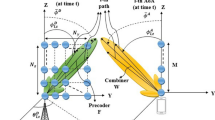Abstract
The energy detector (ED) receiver is a promising solution for time-of-arrival (TOA) based positioning using millimeter-wave (MMW) pulses in multipath environments due to its simple circuitry. Usually in ED receiver, the optimum threshold values required for TOA estimates cannot be acquired particularly when the signal-to-noise ratio (SNR) is low. In this paper, a new ED receiver is discussed based on the results of the ensemble empirical mode decomposition (EEMD) of the received MMW pulses. Meanwhile, the extreme learning machine (ELM) is used to determine optimum threshold values via analyzing the characteristics of the calculated energy samples. The discussed technique can provide efficient threshold values with lower complexity and lower sampling frequency. The proposed receiver is evaluated using measurements obtained in IEEE 802.15.3c models, which show its effectiveness compared to the conventional ED receivers.












Similar content being viewed by others
References
Leonor, N., Caldeirinha, R., Fernandes, T., et al. (2015). A simple model for average reradiation patterns of single trees based on weighted regression at 60GHz. IEEE Transactions on Antennas and Propagation,63(11), 5113–5118.
Song, J., & Chin, K. (2015). A survey of single and multi-hop link schedulers for mmWave wireless systems. Ad Hoc Networks,33, 269–283.
Hazra, R., & Tyagi, A. (2014). A survey on various coherent and non-coherent IR-UWB receivers. Wireless Personal Communications,79(3), 2339–2369.
Liang, X., Zhang, H., Lu, T., et al. (2017). Extreme learning machine for 60 GHz millimeter wave positioning. IET Communications,11(4), 483–489.
Liang, X., Zhang, H., & Gulliver, T. A. (2016). Energy detector based time of arrival estimation using a neural network with millimeter wave signals. KSII Transactions on Internet and Information Systems,10(7), 3050–3065.
Guvenc, I., & Sahinoglu, Z. (2005). Threshold selection for UWB TOA estimation based on kurtosis analysis. IEEE Communications Letter,9(12), 1025–1027.
Guvenc, I., & Sahinoglu, Z. (2005). Multiscale energy products for TOA estimation in IR-UWB systems. In Proceedings of IEEE global telecommunications conference, St. Louis, MO (pp. 209–213).
Liang, X., Jin, Y., Zhang, H., et al. (2018). NLOS identification and machine learning methods for predicting the outcome of 60 GHz ranging system. Chinese Journal of Electronic,27(1), 175–182.
Shafin, R., Liu, L., Li, Y., et al. (2017). Angle and delay estimation for 3D massive MIMO/FD-MIMO systems based on parametric channel modeling. IEEE Transactions on Wireless Communications,16(8), 5370–5383.
Feng, W., Zhi, T., & Sadler, B. (2011). Weighted energy detection for noncoherent ultra-wideband receiver design. IEEE Transactions on Wireless Communications,10(2), 710–720.
Liang, X., Zhang, H., & Lu, T. (2017). Energy detector based TOA estimation for MMW systems using machine learning. Telecommunication Systems,64(2), 417–427.
Wang, T. (2016). An EMD-based filtering algorithm for the fiber-optic SPR sensor. IEEE Photonics Journal,8(3), 1–8.
Liang, X., Zhang, H., Lv, T., et al. (2018). Through-wall human being detection using UWB impulse radar. EURASIP Journal on Wireless Communications,2018(46), 1–17.
Liang, X., Zhang, H., Lyu, T., et al. (2017). A novel time of arrival estimation algorithm using an energy detector receiver in MMW systems. EURASIP Journal on Advances in Signal Processing,2017(83), 1–13.
Liao, A., Shen, C., & Li, P. (2010). Potential contrast improvement in ultrasound pulse inversion imaging using EMD and EEMD. IEEE Transactions on Ultrasonics, Ferroelectrics, and Frequency Control,57(2), 317–326.
Jia, R., Liang, Y., Hua, Y., et al. (2016). Suppressing non-stationary random noise in microseismic data by using ensemble empirical mode decomposition and permutation entropy. Journal of Applied Geophysics,133, 132–140.
Liang, X., Zhang, H., Ye, S., et al. (2018). Improved denoising method for through-wall vital sign detection using UWB impulse radar. Digital Signal Processing,74, 72–93.
Wu, Z., & Huang, N. (2004). A study of the characteristics of white noise using the empirical mode decomposition method. Proceedings Mathematical Physical and Engineering Sciences,460, 1597–1611.
Chen, R., Tang, B., & Ma, J. (2012). Adaptive denoising method based on ensemble empirical mode decomposition for vibration signal. Journal of Vibration and Shock,31(15), 83–86.
Fabian, K. (2015). The experimental results of the bulk-driven quasi-floating-gate MOS transistor. AEÜ-International Journal of Electronics and Communications,69, 462–466.
Peng, Y., Zheng, W., & Lu, B. (2014). An unsupervised discriminative extreme learning machine and its applications to data clustering. Neurocomputing,174(A), 250–264.
Acknowledgements
This work was funded by the Nature Science Foundation of China (41527901), Major Program of China’s Second Generation Satellite Navigation System (GF**********03), Fundamental Research Funds for the Central Universities (201713018), National High Technology Research and Development Program of China (2012AA061403), National Science and Technology Pillar Program during the Twelfth Five-year Plan Period (2014BAK12B00), National Natural Science Foundation of China (61501424), National Natural Science Foundation of China (61701462), Ao Shan Science and Technology Innovation Project of Qingdao National Laboratory for Marine Science and Technology (2017ASKJ01), and the Qingdao Science and Technology Plan (17-1-1-7-jch).
Author information
Authors and Affiliations
Corresponding author
Ethics declarations
Conflict of interest
The authors declare that they have no conflict of interest.
Rights and permissions
About this article
Cite this article
Liang, X., Lv, T. & Zhang, H. An improved method for TOA analysis in MMW systems. Wireless Netw 26, 205–214 (2020). https://doi.org/10.1007/s11276-018-1806-0
Published:
Issue Date:
DOI: https://doi.org/10.1007/s11276-018-1806-0




